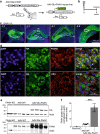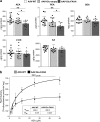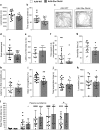Impaired anandamide/palmitoylethanolamide signaling in hippocampal glutamatergic neurons alters synaptic plasticity, learning, and emotional responses
- PMID: 30532004
- PMCID: PMC6784910
- DOI: 10.1038/s41386-018-0274-7
Impaired anandamide/palmitoylethanolamide signaling in hippocampal glutamatergic neurons alters synaptic plasticity, learning, and emotional responses
Abstract
Endocannabinoid signaling via anandamide (AEA) is implicated in a variety of neuronal functions and considered a promising therapeutic target for numerous emotion-related disorders. The major AEA degrading enzyme is fatty acid amide hydrolase (FAAH). Genetic deletion and pharmacological inhibition of FAAH reduce anxiety and improve emotional responses and memory in rodents and humans. Complementarily, the mechanisms and impact of decreased AEA signaling remain to be delineated in detail. In the present study, using the Cre/loxP system combined with an adeno-associated virus (AAV)-mediated delivery system, FAAH was selectively overexpressed in hippocampal CA1-CA3 glutamatergic neurons of adult mice. This approach led to specific FAAH overexpression at the postsynaptic site of CA1-CA3 neurons, to increased FAAH enzymatic activity, and, in consequence, to decreased hippocampal levels of AEA and palmitoylethanolamide (PEA), but the levels of the second major endocannabinoid 2-arachidonoyl glycerol (2-AG) and of oleoylethanolamide (OEA) were unchanged. Electrophysiological recordings revealed an enhancement of both excitatory and inhibitory synaptic activity and of long-term potentiation (LTP). In contrast, excitatory and inhibitory long-term depression (LTD) and short-term synaptic plasticity, apparent as depolarization-induced suppression of excitation (DSE) and inhibition (DSI), remained unaltered. These changes in hippocampal synaptic activity were associated with an increase in anxiety-like behavior, and a deficit in object recognition memory and in extinction of aversive memory. This study indicates that AEA is not involved in hippocampal short-term plasticity, or eLTD and iLTD, but modulates glutamatergic transmission most likely via presynaptic sites, and that disturbances in this process impair learning and emotional responses.
Figures





Comment in
-
Buzzkill: the consequences of depleting anandamide in the hippocampus.Neuropsychopharmacology. 2019 Jul;44(8):1347-1348. doi: 10.1038/s41386-019-0357-0. Epub 2019 Mar 1. Neuropsychopharmacology. 2019. PMID: 30824852 Free PMC article. No abstract available.
Similar articles
-
Full inhibition of spinal FAAH leads to TRPV1-mediated analgesic effects in neuropathic rats and possible lipoxygenase-mediated remodeling of anandamide metabolism.PLoS One. 2013;8(4):e60040. doi: 10.1371/journal.pone.0060040. Epub 2013 Apr 3. PLoS One. 2013. PMID: 23573230 Free PMC article.
-
Elevation of endogenous anandamide impairs LTP, learning, and memory through CB1 receptor signaling in mice.Hippocampus. 2014 Jul;24(7):808-18. doi: 10.1002/hipo.22272. Epub 2014 Mar 28. Hippocampus. 2014. PMID: 24648181 Free PMC article.
-
Upregulation of Anandamide Hydrolysis in the Basolateral Complex of Amygdala Reduces Fear Memory Expression and Indices of Stress and Anxiety.J Neurosci. 2019 Feb 13;39(7):1275-1292. doi: 10.1523/JNEUROSCI.2251-18.2018. Epub 2018 Dec 20. J Neurosci. 2019. PMID: 30573646 Free PMC article.
-
Fatty acid amide hydrolase: biochemistry, pharmacology, and therapeutic possibilities for an enzyme hydrolyzing anandamide, 2-arachidonoylglycerol, palmitoylethanolamide, and oleamide.Biochem Pharmacol. 2001 Sep 1;62(5):517-26. doi: 10.1016/s0006-2952(01)00712-2. Biochem Pharmacol. 2001. PMID: 11585048 Review.
-
Fatty acid amide hydrolase, an enzyme with many bioactive substrates. Possible therapeutic implications.Curr Pharm Des. 2002;8(7):533-47. doi: 10.2174/1381612023395655. Curr Pharm Des. 2002. PMID: 11945157 Review.
Cited by
-
Anandamide Signaling Augmentation Rescues Amygdala Synaptic Function and Comorbid Emotional Alterations in a Model of Epilepsy.J Neurosci. 2020 Jul 29;40(31):6068-6081. doi: 10.1523/JNEUROSCI.0068-20.2020. Epub 2020 Jun 29. J Neurosci. 2020. PMID: 32601243 Free PMC article.
-
Fatty acid amide hydrolase in major depressive episodes: A [11C]CURB positron emission tomography study.Neuropsychopharmacology. 2025 Sep;50(10):1536-1543. doi: 10.1038/s41386-025-02150-y. Epub 2025 Jun 23. Neuropsychopharmacology. 2025. PMID: 40550956 Free PMC article.
-
Fatty-acid amide hydrolase inhibition mitigates Alzheimer's disease progression in mouse models of amyloidosis.FEBS J. 2025 Aug;292(16):4160-4182. doi: 10.1111/febs.17403. Epub 2025 Jan 16. FEBS J. 2025. PMID: 39822137 Free PMC article.
-
Buzzkill: the consequences of depleting anandamide in the hippocampus.Neuropsychopharmacology. 2019 Jul;44(8):1347-1348. doi: 10.1038/s41386-019-0357-0. Epub 2019 Mar 1. Neuropsychopharmacology. 2019. PMID: 30824852 Free PMC article. No abstract available.
-
Dynamic Balance of Microglia and Astrocytes Involved in the Remyelinating Effect of Ginkgolide B.Front Cell Neurosci. 2020 Jan 8;13:572. doi: 10.3389/fncel.2019.00572. eCollection 2019. Front Cell Neurosci. 2020. PMID: 31969806 Free PMC article.
References
Publication types
MeSH terms
Substances
LinkOut - more resources
Full Text Sources
Molecular Biology Databases
Miscellaneous

